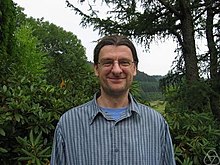Aise Johan de Jong
Aise Johan de Jong | |
|---|---|
 | |
| Born | 30 January 1966 |
| Nationality | Dutch |
| Alma mater | Radboud University NijmegenLeiden University |
| Awards | Cole Prize (2000) EMS Prize (1996) |
| Scientific career | |
| Fields | Mathematics |
| Institutions | Columbia UniversityMassachusetts Institute of Technology |
| Doctoral advisor | Frans Oort Joseph H. M. Steenbrink |
| Doctoral students | Bhargav BhattKiran Kedlaya |
Aise Johan de Jong (born 30 January 1966)[1] is a Dutch mathematician born in Belgium. He currently is a professor of mathematics at Columbia University. His research interests include arithmetic geometry and algebraic geometry.
Education[]
De Jong attended high school in The Hague, obtained his master's degree at Leiden University and earned his doctorate at the Radboud University Nijmegen in 1992, under supervision of Frans Oort and Joseph H. M. Steenbrink.[2]
Career[]
In 1996, de Jong developed his theory of alterations which was used by Fedor Bogomolov and Tony Pantev (1996) and Dan Abramovich and de Jong (1997) to prove resolution of singularities in characteristic 0 and to prove a weaker result for varieties of all dimensions in characteristic p which is strong enough to act as a substitute for resolution for many purposes.[3][4][5]
In 2005, de Jong started the Stacks Project, "an open source textbook and reference work on algebraic stacks and the algebraic geometry needed to define them."[6] The book that the project has generated currently runs to more than 6,000 pages as of March 2018.[7]
Awards and honors[]
In 1998 he was an Invited Speaker of the International Congress of Mathematicians in Berlin.[8] He won the Cole Prize in 2000 for his theory of alterations.[1] In the same year, De Jong became a correspondent of the Royal Netherlands Academy of Arts and Sciences.[9]
Personal life[]
De Jong lives in New York City with his wife, Cathy O'Neil, and their three sons.[10]
Selected works[]
- De Jong, A. J. (1996). "Smoothness, semi-stability and alterations". Publications Mathématiques de l'IHÉS. 83: 51–93. CiteSeerX 10.1.1.39.7544. doi:10.1007/bf02698644. S2CID 53581802.
- The Stacks Project
References[]
- ^ Jump up to: a b c 2000 Cole Prize
- ^ Aise Johan de Jong at the Mathematics Genealogy Project
- ^ de Jong, A. J. (1996), "Smoothness, semi-stability and alterations", Inst. Hautes Études Sci. Publ. Math., 83: 51–93, doi:10.1007/BF02698644, S2CID 53581802
- ^ Bogomolov, Fedor A.; Pantev, Tony G. (1996), "Weak Hironaka theorem", Mathematical Research Letters, 3 (3): 299–307, arXiv:alg-geom/9603019, Bibcode:1996alg.geom..3019B, doi:10.4310/mrl.1996.v3.n3.a1, S2CID 14010069
- ^ Abramovich, D; de Jong, A. J. (1997), "Smoothness, semistability, and toroidal geometry", Journal of Algebraic Geometry, 6 (4): 789–801, arXiv:alg-geom/9603018, Bibcode:1996alg.geom..3018A, MR 1487237
- ^ "The Stacks Project » About". columbia.edu. Retrieved 30 August 2013.
- ^ Johan de Jong; et al. The Stacks Project (PDF). Retrieved 29 January 2017.
- ^ de Jong, A. J. (1998). "Barsotti-Tate groups and crystals". Doc. Math. (Bielefeld) Extra Vol. ICM Berlin, 1998, vol. II. pp. 259–265.
- ^ "Aise de Jong". Royal Netherlands Academy of Arts and Sciences. Retrieved 4 August 2015.
- ^ "mathbabe.org about page". Retrieved 25 July 2013.
External links[]
- Aise Johan de Jong at the Mathematics Genealogy Project
- Website at Columbia University
- The Stacks Project
- 1966 births
- Living people
- Belgian mathematicians
- 20th-century Dutch mathematicians
- 21st-century mathematicians
- Leiden University alumni
- Radboud University Nijmegen alumni
- Massachusetts Institute of Technology faculty
- Members of the Royal Netherlands Academy of Arts and Sciences
- Columbia University faculty
- Scientists from Bruges
- Arithmetic geometers
- Dutch scientist stubs